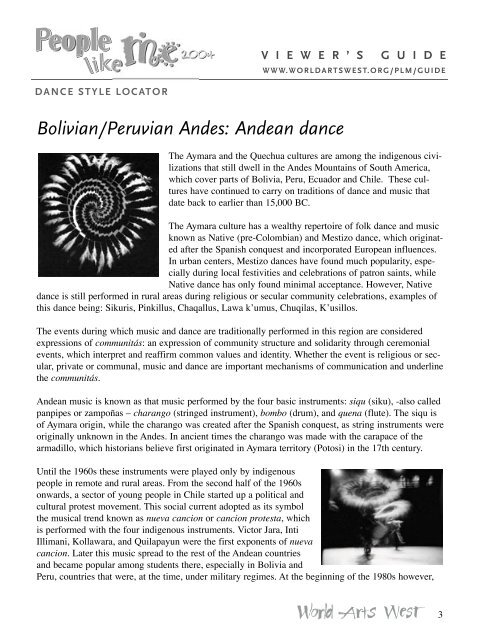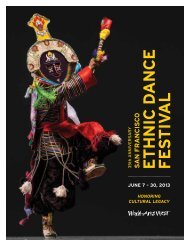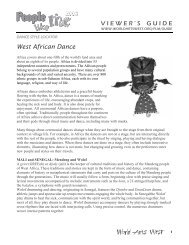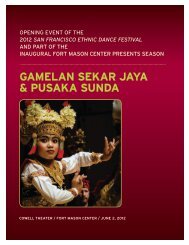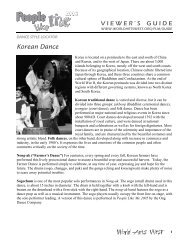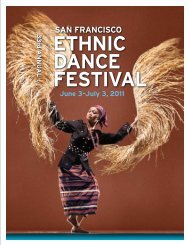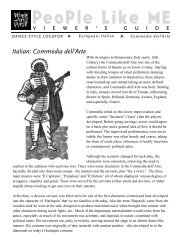South African: Gumboot dance - World Arts West
South African: Gumboot dance - World Arts West
South African: Gumboot dance - World Arts West
Create successful ePaper yourself
Turn your PDF publications into a flip-book with our unique Google optimized e-Paper software.
V I E W E R ’ S G U I D E<br />
W W W. W O R L D A R T S W E S T. O R G / P L M / G U I D E<br />
DANCE STYLE LOCATOR<br />
Bolivian/Peruvian Andes: Andean <strong>dance</strong><br />
The Aymara and the Quechua cultures are among the indigenous civilizations<br />
that still dwell in the Andes Mountains of <strong>South</strong> America,<br />
which cover parts of Bolivia, Peru, Ecuador and Chile. These cultures<br />
have continued to carry on traditions of <strong>dance</strong> and music that<br />
date back to earlier than 15,000 BC.<br />
The Aymara culture has a wealthy repertoire of folk <strong>dance</strong> and music<br />
known as Native (pre-Colombian) and Mestizo <strong>dance</strong>, which originated<br />
after the Spanish conquest and incorporated European influences.<br />
In urban centers, Mestizo <strong>dance</strong>s have found much popularity, especially<br />
during local festivities and celebrations of patron saints, while<br />
Native <strong>dance</strong> has only found minimal acceptance. However, Native<br />
<strong>dance</strong> is still performed in rural areas during religious or secular community celebrations, examples of<br />
this <strong>dance</strong> being: Sikuris, Pinkillus, Chaqallus, Lawa kʼumus, Chuqilas, Kʼusillos.<br />
The events during which music and <strong>dance</strong> are traditionally performed in this region are considered<br />
expressions of communitás: an expression of community structure and solidarity through ceremonial<br />
events, which interpret and reaffirm common values and identity. Whether the event is religious or secular,<br />
private or communal, music and <strong>dance</strong> are important mechanisms of communication and underline<br />
the communitás.<br />
Andean music is known as that music performed by the four basic instruments: siqu (siku), -also called<br />
panpipes or zampoñas – charango (stringed instrument), bombo (drum), and quena (flute). The siqu is<br />
of Aymara origin, while the charango was created after the Spanish conquest, as string instruments were<br />
originally unknown in the Andes. In ancient times the charango was made with the carapace of the<br />
armadillo, which historians believe first originated in Aymara territory (Potosi) in the 17th century.<br />
Until the 1960s these instruments were played only by indigenous<br />
people in remote and rural areas. From the second half of the 1960s<br />
onwards, a sector of young people in Chile started up a political and<br />
cultural protest movement. This social current adopted as its symbol<br />
the musical trend known as nueva cancion or cancion protesta, which<br />
is performed with the four indigenous instruments. Victor Jara, Inti<br />
Illimani, Kollawara, and Quilapayun were the first exponents of nueva<br />
cancion. Later this music spread to the rest of the Andean countries<br />
and became popular among students there, especially in Bolivia and<br />
Peru, countries that were, at the time, under military regimes. At the beginning of the 1980s however,<br />
3


